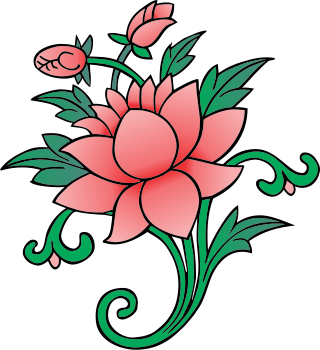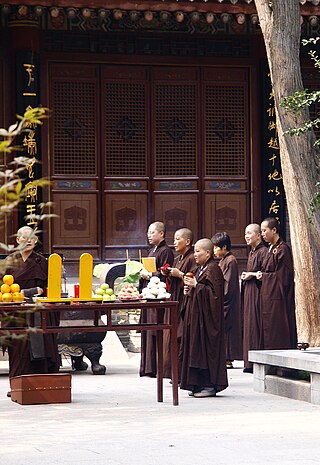
Sangha is a Pali word used in many Indian languages,including Sanskrit which means "association","assembly","company" or "community";in these languages,sangha is frequently used as a surname. In a political context,it was historically used to denote a governing assembly in a republic or a kingdom,and for a long time,it has been used by religious associations,including Buddhists,Jains and Sikhs. Given this history,some Buddhists have stated that the tradition of the sangha represents humanity's oldest surviving democratic institution.

Tibetan Buddhism is a form of Buddhism practiced in Tibet,Bhutan and Mongolia. It also has a sizable number of adherents in the areas surrounding the Himalayas,including the Indian regions of Ladakh,Darjeeling,Sikkim,and Zangnan,as well as in Nepal. Smaller groups of practitioners can be found in Central Asia,some regions of China such as Northeast China,Xinjiang,Inner Mongolia and some regions of Russia,such as Tuva,Buryatia,and Kalmykia.

Buddhism was first established in Japan in the 6th century CE. Most of the Japanese Buddhists belong to new schools of Buddhism which were established in the Kamakura period (1185-1333). During the Edo (Tokugawa)-period (1603–1868),Buddhism was controlled by the feudal Shogunate. The Meiji-period (1868–1912) saw a strong response against Buddhism,with persecution and a forced separation between Buddhism and Shinto.

A bhikkhu is an ordained male in Buddhist monasticism. Male and female monastics are members of the Sangha.
In Chan and Zen Buddhism,dharma transmission is a custom in which a person is established as a "successor in an unbroken lineage of teachers and disciples,a spiritual 'bloodline' (kechimyaku) theoretically traced back to the Buddha himself." The dharma lineage reflects the importance of family-structures in ancient China,and forms a symbolic and ritual recreation of this system for the monastical "family".

The term American Buddhism can be used to describe all Buddhist groups within the United States,including Asian-American Buddhists born into the faith,who comprise the largest percentage of Buddhists in the country.

Upāsaka (masculine) or Upāsikā (feminine) are from the Sanskrit and Pāli words for "attendant". This is the title of followers of Buddhism who are not monks,nuns,or novice monastics in a Buddhist order,and who undertake certain vows. In modern times they have a connotation of dedicated piety that is best suggested by terms such as "lay devotee" or "devout lay follower".

Buddhist monasticism is one of the earliest surviving forms of organized monasticism and one of the fundamental institutions of Buddhism. Monks and nuns,called bhikkhu and bhikkhuni,are responsible for the preservation and dissemination of the Buddha's teaching and the guidance of Buddhist lay people. Three surviving traditions of monastic discipline (Vinaya),govern modern monastic life in different regional traditions:Theravada,Dharmaguptaka,and Mulasarvastivada.
The Pratimokṣa is a list of rules governing the behaviour of Buddhist monastics. Prati means "towards" and mokṣa means "liberation" from cyclic existence (saṃsāra).
The Order of Interbeing is an international Buddhist community of monks,nuns and laypeople in the Plum Village Tradition founded between 1964 and 1966 by Vietnamese Buddhist monk Thích Nhất Hạnh.

A sāmaṇera (Pali),,is a novice male monk in a Buddhist context. A female novice nun is a sāmaṇerī (Pali),and a śrāmaṇerī or śrāmaṇerikā (Sanskrit). In Tibetan and in Tibetan Buddhism,a female novice nun is a getsulma,and a male novice monk is a getsul.

Shihō (嗣法) refers to a series of ceremonies in SōtōZen Buddhism wherein a unsui receives Dharma transmission,becoming part of the dharma lineage of his or her teacher.

Women in Buddhism is a topic that can be approached from varied perspectives including those of theology,history,anthropology,and feminism. Topical interests include the theological status of women,the treatment of women in Buddhist societies at home and in public,the history of women in Buddhism,and a comparison of the experiences of women across different forms of Buddhism. As in other religions,the experiences of Buddhist women have varied considerably.

The Bodhisattva Precepts are a set of ethical trainings (śīla) used in Mahāyāna Buddhism to advance a practitioner along the path to becoming a bodhisattva. Traditionally,monastics observed the basic moral code in Buddhism,the prātimokṣa,but in the Mahāyāna tradition,monks may observe the Bodhisattva Precepts as well. The Bodhisattva Precepts are associated with the bodhisattva vow to save all beings and with bodhicitta.
The Taego Order or Taego-jong is the second largest order in Korean Seon,the Korean branch of Chan Buddhism.
Zen master is a somewhat vague English term that arose in the first half of the 20th century,sometimes used to refer to an individual who teaches Zen Buddhist meditation and practices,usually implying longtime study and subsequent authorization to teach and transmit the tradition themselves.

Buddhism is a religion and philosophy encompassing a variety of traditions,beliefs and practices,largely based on teachings attributed to Siddhartha Gautama,commonly known as the Buddha,"the awakened one".

A bhikkhunī or bhikṣuṇī is a Buddhist nun,fully ordained female in Buddhist monasticism. Bhikkhunīs live by the Vinaya,a set of either 311 Theravada,348 Dharmaguptaka,or 364 Mulasarvastivada school rules. Until recently,the lineages of female monastics only remained in Mahayana Buddhism and thus were prevalent in countries such as China,Korea,Taiwan,Japan,and Vietnam,while a few women have taken the full monastic vows in the Theravada and Vajrayana schools. The official lineage of Tibetan Buddhist bhikkhunīs recommenced on 23 June 2022 in Bhutan when 144 nuns,most of them Butanese,were fully ordained.
Zen was introduced in the United States at the end of the 19th century by Japanese teachers who went to America to serve groups of Japanese immigrants and become acquainted with the American culture. After World War II,interest from non-Asian Americans grew rapidly. This resulted in the commencement of an indigenous American Zen tradition which also influences the larger western (Zen) world.

In Buddhism,the abbot is the head of a Buddhist monastery or large Buddhist temple. In Buddhist nunneries,the nun who holds the equivalent position is known as the abbess.












